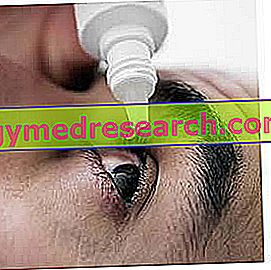Definition of eye drops
Eye drops are drugs or natural preparations to be administered in the eye in the form of drops. There are many types of eye drops: some are intended for the treatment of ophthalmic pathologies (eg glaucoma, uveitis, etc.), while others are reserved for the improvement of non-pathological eye disorders (eg red eyes, dry eyes, etc.).

Types of eye drops
There are many types of eye drops, classified according to the active functional principle contained in the preparation, the frequency of application and the duration of therapy. Among the most noteworthy, we recall:
- Antihistamine-decongestant eye drops, indicated for the treatment of seasonal allergies and allergic reactions to drugs or other substances.
- Eye drops against dry eyes: these types of eye drops are enriched with humectants, which are essential to guarantee the right degree of moisture to the eye.
- Eye drops against red eyes: these formulations do not normally require medical prescription, being intended for the improvement of a transient disorder, linked for example to atmospheric insults or to the penetration of a foreign body in the eye (eg eyelashes or contact lens).
- Antibiotic / antiviral eye drops: aqueous solutions enriched with antibiotic or antiviral active ingredients. These types of eye drops are indicated for all ophthalmic pathologies characterized by proven bacterial or viral infection. For example, antibiotic eye drops are indicated for the treatment of conjunctivitis and uveitis.
- Eye drops enriched with steroidal active ingredients: they are powerful ocular anti-inflammatories, indicated in case of serious inflammatory phenomena, which cannot be repaired by other drugs with a more moderate action.
- Eye drops for the treatment of glaucoma: these are pharmacological preparations aimed at reducing intraocular pressure. Let us briefly recall that glaucoma is a disorder characterized by an alteration of the pressure inside the eye.
- Eye drops for mydriatic effect: these types of eye drops are mainly used for diagnostic purposes, in order to dilate the pupil to favor the examination of the eye structures. They are also sometimes used in decongestant therapy in the context of conjunctivitis.
Eye drops for allergies
The eye drops used to improve the symptoms induced by allergic reactions are formulated with DECONGESTANT and ANTISTAMINIC substances.
- There are no drugs that can cure an allergy: "antiallergic" medicines can simply restore or improve the symptoms induced by the allergic reaction.
Seasonal allergic conjunctivitis recurs punctually in the spring; for this, it is good to prevent allergy by starting a prophylactic therapy with decongesting eye drops in the first weeks of March.
The eye drops with decongestant action contain vasoconstrictor substances, able to induce a narrowing of the blood vessels of the conjunctiva. These types of eye drops are for free sale, ie they do not require medical prescription. However, it is good not to abuse it: the decongesting eye drops must be administered for a period not exceeding 3-4 consecutive days. The dosage plans to instill no more than 2 drops per eye, 3 times a day.
An inadequate / immoderate use of eye drops, in the long run, can cause a worsening of eye congestion. Unless otherwise indicated by the doctor, antihistamine drops are contraindicated for patients suffering from hypertension, diabetes and hyperthyroidism.
To support the therapeutic action of decongesting eye drops, delicate chamomile packs - to be applied directly in the eye with the aid of a cotton pad - are very indicated to provide immediate relief: after cooling a chamomile infusion, immerse yourself a cotton pad and make a pack in the eyes. Keep the cotton in position for a few seconds and repeat the operation several times, using a clean wad for each pack.
Below is the formulation of an eye drop indicated in the treatment of eye irritation, redness, congestion and itching triggered by allergic, chemical or physical causes (fumes, dust, bright lights, solar or snow glare).
- solution in bottle: active ingredient: Tetrizoline hydrochloride 50/100 ml mg; Excipients: distilled chamomile water - distilled linden water - sodium phosphate dodecahydrate - hydrogen phosphate potassium - sodium chloride - sodium edetate - polysorbate 80 - benzalkonium chloride - purified water.
- solution in single-dose container: Active ingredient: Tetrizoline hydrochloride 50/100 ml mg; water; Excipients: sodium phosphate dodecahydrate - sodium dihydrogen phosphate - sodium edetate - sodium chloride - purified water.
Eye drops against dry eyes
A valid eye drops specifically designed to combat dryness (better called xerosis ) ocular must imitate the characteristics of lacrimal mucus, be slightly alkaline, isotonic with the tear film and naturally free of preservatives. To this end, single-dose ampoules of eye drops (to be used only once) containing mucopolysaccharides (eg hyaluronic acid), cellulose derivatives, synthetic polymers (eg polyvinyl alcohol, povidone, carbopol, macrogol) and substances are particularly indicated. mucomimetic drugs such as galactoxylglucan.
To prevent dry eyes, the application of so-called artificial tears, a type of eye drops formulated with viscous substances capable of replacing tear fluid, is sometimes recommended.
When treatment with this type of eye drops does not improve dry eyes, a more thorough diagnostic investigation is necessary: the ocular xerosis can in fact hide nutritional-vitamin deficiencies or bacterial infections. In the first case, it is recommended to enrich the diet by taking specific supplements (eg vitamin A supplement, in the case of retinol deficiency); in the presence of an eye infection, it is advisable instead to follow a topical antibiotic treatment.
Note
- While not requiring a medical prescription, these types of eye drops must be used in full compliance with the indicated dosage. The thoughtless use of eye drops can in fact cause serious side effects such as keratitis or irritative forms of conjunctivitis.
- It is always recommended to read the leaflet of the eye drops carefully and to warn the doctor before instilling the product in the eye. Avoid simultaneously using eye drops containing hyaluronic acid and disinfectant solutions for eyes: in the presence of quaternary ammonium salts (substances used as preservatives and antimicrobials), in fact, hyaluronic acid tends to precipitate.
Below is the formulation of an eye drop indicated in the treatment of dry eye syndrome
- solution in bottle: 1 ml of eye drops, solution contains: Active ingredient: Hyaluronic acid sodium salt 2 mg; Excipients: Sodium chloride - Potassium chloride - Sodium phosphate monobasic monohydrate - Disodium phosphate dodecahydrate - Thiomersal - Purified water.
- solution in a single-dose container: Sodium chloride - Potassium chloride - Sodium phosphate monobasic monohydrate - Disodium phosphate dodecahydrate - Purified water.
Eye drops for red eyes
Red eyes are a rather common condition after prolonged exposure to light sources (eg tanning lamps, xenon headlights etc.), atmospheric agents (air, sun, air pollution) or after long hours of work or intense reading.
The red eyes, the burning, the tearing and the dryness typical of these circumstances tend to resolve when the cause that caused the disorder is removed. However, in the presence of particularly sensitive eyes, some types of eye drops can speed up their health: eye preparations enriched with decongestant and emollient substances are preferable.
Did you know that ...
Even homeopathy can help to alleviate redness and burning eyes: experts recommend eye drops enriched with Euphrasia and Chamomile.
Steroid eye drops
For the treatment of all serious inflammatory phenomena affecting the eye, the most indicated eye drops are those formulated with corticosteroids, possibly supported by a topical therapy with antibiotic eye drops.
The formulation of the STEROID COLLIRES is rather complex due to the poor solubility of the active ingredients in the water: to overcome this drawback the drugs slightly soluble in aqueous solvent are administered in the form of suspension (thermodynamically unstable systems, tending to sedimentation and aggregation, require to be shaken before use).
The most commonly used active ingredients for preparing this type of eye drops are: Cortisone, Fluorometolone, hydrocortisone and Dexamethasone.
Steroid eye drops require medical prescription.
Antibiotic / antiviral eye drops
The eye drops enriched with antibiotic active principles are indicated in the treatment of all infectious forms affecting the eye in general and the conjunctiva in particular. For this purpose, ANTIBIOTIC and ANTIVIRAL COLLIRES are used above all in the treatment of bacterial / viral conjunctivitis and infectious uveitis.
These types of eye drops, which require a prescription, should be chosen based on the pathogen responsible for the infection. For example, for the treatment of an eye infection sustained by Pseudomonas aeruginosa the most indicated eye drops are formulated with gentamicin; fusidic acid is recommended for bacterial staphylococcal conjunctivitis. The most used antiviral eye drops are instead prepared with Diclofenac or Ketorolac, active substances belonging to the class of NSAIDs (non-Steroidal anti-inflammatory drugs) useful for mitigating the symptoms of infection ..
When the eye infection is accompanied by a marked inflammation, it is recommended to combine the antibiotic treatment with another type of corticosteroid based eye drops. There are also some types of eye drops containing a mixture of antibiotic + anti-inflammatory active ingredients.
Eye drops for glaucoma
Defined as a silent thief of sight, glaucoma is a subtle and difficult to identify eye disease because it does not begin with any appreciable symptoms.
In general, the first symptoms of the disease manifest themselves when the sight is now compromised. The use of specific eye drops for the treatment of glaucoma is essential to block the evolution of the disease, minimizing the damage to the eyes.
The most suitable types of eye drops to fight glaucoma are:
- Beta-blockers, essential to reduce the altered pressure inside the eye. These medicated eye drops - which require the doctor's prescription - act actively in the aqueous humor, reducing its production. The active ingredients most used for this purpose are: Metoprolol, Timolol and Betaxolol.
- PG analogues (prostglandins): after a specific cure with this type of eye drops, intraocular pressure is reduced because the outflow of aqueous humor is favored. A typical side effect of these eye drops is the hyperpigmentation of the iris.
- Sympathomimetics (eg. Brimonidina, Pilocarpine): second choice eye drops for the treatment of glaucoma. The side effects typical of these drugs (eg abundant watery eyes, conjunctival hyperemia) constitute an effective obstacle to therapy; therefore, these types of eye drops are not always indicated to cure the disease.
Mydriatic eye drops
These pharmacological preparations - available both in the form of eye drops and as ointment or ophthalmic gel - are indicated for the treatment of eye infections and inflammations. Mydriatic eye drops are generally prepared with muscarinic antagonist drugs such as Cyclopentolate, Omatropin, Phenylephrine and Atropine.
By determining an evident dilation of the pupil, this type of eye drops is also indicated to prevent the formation of posterior sinews (pathological adhesions that form in the internal structures of the eye) in the context of uveitis.



